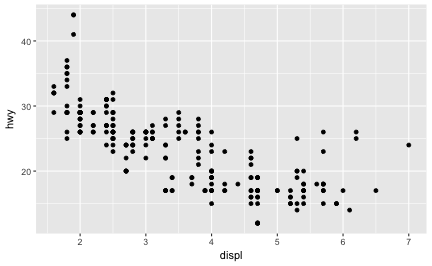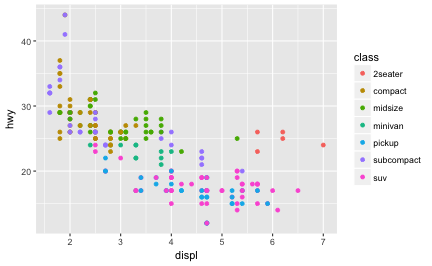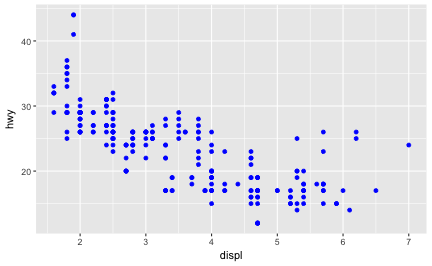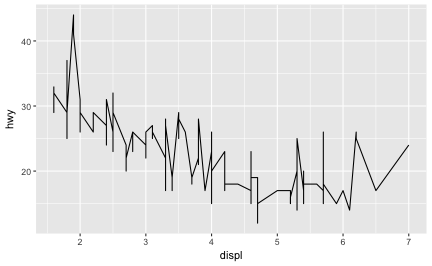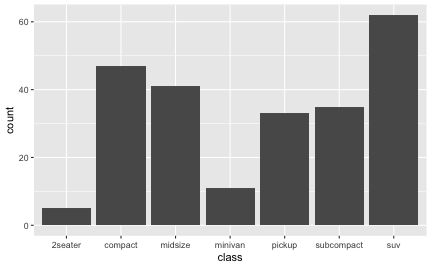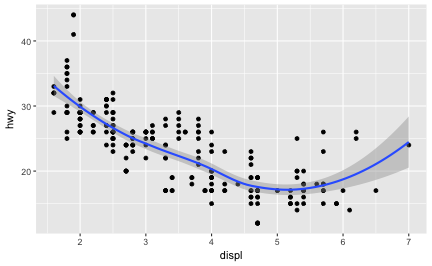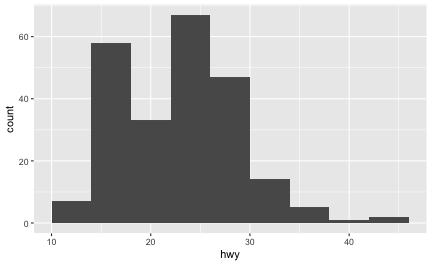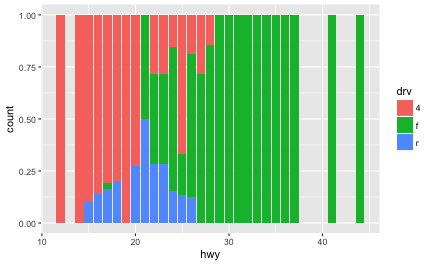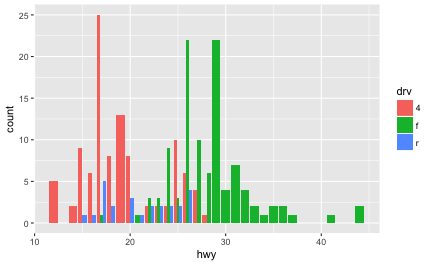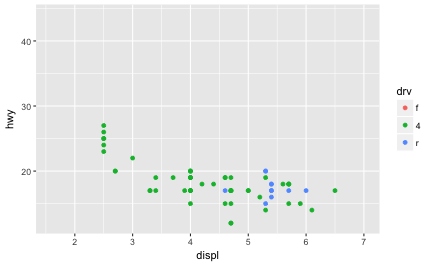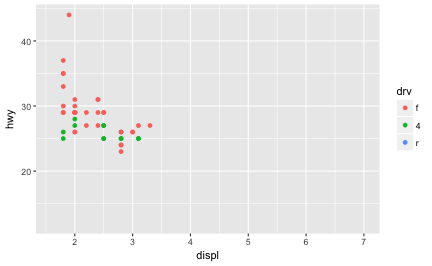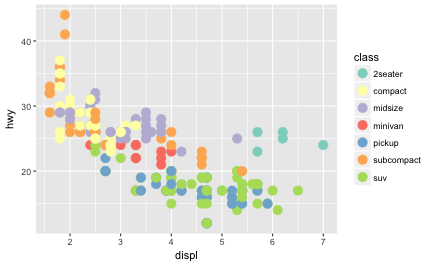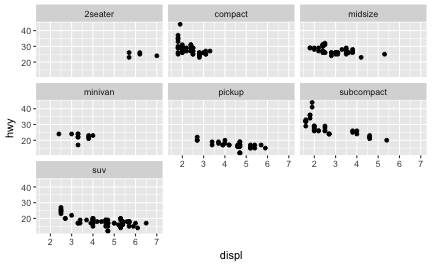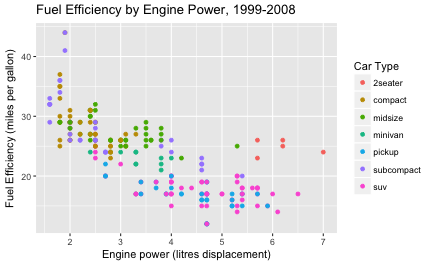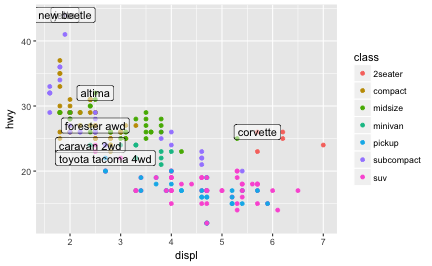Being able to create visualizations (graphical representations) of data is a key step in being able to communicate information and findings to others. In this module you will learn to use the ggplot2 library to declaratively make beautiful plots or charts of your data.
Although R does provide built-in plotting functions, the ggplot2 library implements the Grammar of Graphics (similar to how dplyr implements a Grammar of Data Manipulation; indeed, both packages were developed by the same person). This makes it particularly effective for describing how visualizations should represent data, and has turned it into the preeminent plotting library in R.
Learning this library will allow you to easily make nearly any kind of (static) data visualization, customized to your exact specifications.
(Examples in this module adapted from R for Data Science).
Helpful links:
- gglot2 Documentation (particularly the function reference)
- ggplot2 Cheat Sheet (see also here)
- Data Visualization (R4DS) - tutorial using
ggplot2 - Graphics for Communication (R4DS) - "part 2" of tutorial using
ggplot - Graphics with ggplot2 - explanation of
qplot() - Telling stories with the grammar of graphics
- A Layered Grammar of Graphics (Wickham)
Just as the grammar of language helps us construct meaningful sentences out of words, the Grammar of Graphics helps us to construct graphical figures out of different visual elements. This grammar gives us a way to talk about parts of a plot: all the circles, lines, arrows, and words that are combined into a diagram for visualizing data. Originally developed by Leland Wilkinson, the Grammar of Graphics was adapted by Hadley Wickham to describe the components of a plot, including
- the data being plotted
- the geometric objects (circles, lines, etc.) that appear on the plot
- a set of mappings from variables in the data to the aesthetics (appearance) of the geometric objects
- a statistical transformation used to calculate the data values used in the plot
- a position adjustment for locating each geometric object on the plot
- a scale (e.g., range of values) for each aesthetic mapping used
- a coordinate system used to organize the geometric objects
- the facets or groups of data shown in different plots
Wickham further organizes these components into layers, where each layer has a single geometric object, statistical transformation, and position adjustment. Following this grammar, you can think of each plot as a set of layers of images, where each image's appearance is based on some aspect of the data set.
All together, this grammar enables us to discuss what plots look like using a standard set of vocabulary. And like with dplyr and the Grammar of Data Manipulation, ggplot2 uses this grammar directly to declare plots, allowing you to more easily create specific visual images.
The ggplot2 library provides a set of declarative functions that mirror the above grammar, enabling us to efficaciously specify what we want a plot to look like (e.g., what data, geometric objects, aesthetics, scales, etc. we want it to have).
ggplot2 is yet another external package (like dplyr and httr and jsonlite), so you will need to install and load it in order to use it:
install.packages("ggplot2") # once per machine
library("ggplot2")This will make all of the plotting functions you'll need available.
- Note that the library also comes with a number of built-in data sets. This module will use the provided
mpgdata set as an example, which is a data frame contains information about fuel economy for different cars.
In order to create a plot, you call the ggplot() function, specifying the data that you wish to plot. You then add new layers that are geometric objects which will show up on the plot:
# plot the `mpg` data set, with highway milage on the x axis and
# engine displacement (power) on the y axis:
ggplot(data = mpg) +
geom_point(mapping = aes(x = displ, y = hwy))To walk through the above code:
-
The
ggplot()function is passed the data frame to plot as thedataargument. -
You specify a geometric object (
geom) by calling one of the manygeomfunctions, which are all namedgeom_followed by the name of the kind of geometry you wish to create. For example,geom_point()will create a layer with "point" (dot) elements as the geometry. There are large number of these functions; see below for more details. -
For each
geomyou must specify the aesthetic mappings, which is how data from the data frame will be mapped to visual aspects. These mappings are defined using theaes()function. Theaes()function takes a set of arguments (like a list), where the name is the visual property to map to, and the value is the data property to map from. -
Finally, you add
geomlayers to the plot by using the addition (+) operator.
Thus basic simple plots can be created simply by specifying a data set, a geom, and a set of aesthetic mappings.
- Note that
ggplot2library does include aqplot()function for creating "quick plots", which acts as a convenient shortcut for making simple, "default"-like plots. However, for this course you should focus on thinking about plots in terms of the Grammar of Graphics and use theggplot()function instead.
The aesthetic mappings take properties of the data and use them to influence visual channels, such as position, color, size, or shape. Each visual channel can thus encode an aspect of the data and be used to convey information.
All aesthetics for a plot are specified in the aes() function call for that geom layer. For example, we can add a mapping from the class of the cars to the color channel:
# color the data by car type
ggplot(data = mpg) +
geom_point(mapping = aes(x = displ, y = hwy, color = class))(ggplot2 will even create a legend for you!)
Note that using the aes() function will cause the visual channel to be based on the data specified in the argument. For example, using aes(color = "blue") won't cause the geometry's color to be "blue", but will instead cause the visual channel to be mapped from the vector c("blue")—as if we only had a single type of engine that happened to be called "blue". If you wish to apply an aesthetic property to an entire geometry, you can set that property as an argument to the geom method, outside of the aes() call:
ggplot(data = mpg) +
geom_point(mapping = aes(x = displ, y = hwy), color = "blue") # blue points!Building on these basics, ggplot2 can be used to build almost any kind of plot you may want. These plots are declared using functions that follow from the Grammar of Graphics.
The most obvious distinction between plots is what geometric objects (geoms) they include. ggplot2 supports a number of different types of geoms, including:
geom_pointfor drawing individual points (e.g., a scatter plot)geom_linefor drawing lines (e.g., for a line charts)geom_smoothfor drawing smoothed lines (e.g., for simple trends or approximations)geom_barfor drawing bars (e.g., for bar charts)geom_polygonfor drawing arbitrary shapesgeom_mapfor drawing polygons in the shape of a map! (You can access the data to use for these maps by using themap_data()function).
Each of these geometries will need to include a set of aesthetic mappings (using the aes() function and assigned to the mapping argument), though the specific visual properties that the data will map to will vary. For example, you can map data to the shape of a geom_point (e.g., if they should be circles or squares), or you can map data to the linetype of a geom_line (e.g., if it is solid or dotted), but not vice versa.
- Almost all
geomsrequire anxandymapping at the bare minimum.
# line chart of milage by engine power
ggplot(data = mpg) +
geom_line(mapping = aes(x = displ, y = hwy))
# bar chart of car type
ggplot(data = mpg) +
geom_bar(mapping = aes(x = class)) # no y mapping needed!What makes this really powerful is that you can add multiple geometries to a plot, thus allowing you to create complex graphics showing multiple aspects of your data
#plot with both points and smoothed line
ggplot(data = mpg) +
geom_point(mapping = aes(x = displ, y = hwy)) +
geom_smooth(mapping = aes(x = displ, y = hwy))Of course the aesthetics for each geom can be different, so you could show multiple lines on the same plot (or with different colors, styles, etc). It's also possible to give each geom a different data argument, so that you can show multiple data sets in the same plot.
- If you want multiple
geomsto utilize the same data or aesthetics, you can pass those values as arguments to theggplot()function itself; anygeomsadded to that plot will use the values declared for the whole plot unless overridden by individual specifications.
If you look at the above bar chart, you'll notice that the the y axis was defined for us as the count of elements that have the particular type. This count isn't part of the data set (it's not a column in mpg), but is instead a statistical transformation that the geom_bar automatically applies to the data. In particular, it applies the stat_count transformation.
ggplot2 supports many different statistical transformations. For example, the "identity" transformation will leave the data "as is". You can specify which statistical transformation a geom uses by passing it as the stat argument:
# silly example: bar chart of engine power vs. milage
# (we need the `y` mapping since it is not implied by the stat transform
ggplot(data = mpg) +
geom_bar(mapping = aes(x = displ, y = hwy), stat="identity")Additionally, ggplot2 contains stat_ functions (e.g., stat_identity for the "identity" transformation) that can be used to specify a layer in the same way a geom does:
# generate a "binned" (grouped) display of highway milage
ggplot(data = mpg) +
stat_bin(aes(x=hwy, color=hwy), binwidth=4) # binned into groups of 4 unitsNotice the above chart is actually a histogram! Indeed, almost every stat transformation corresponds to a particular geom (and vice versa) by default. Thus they can often be used interchangeably, depending on how you want to emphasize your layer creation.
# these two charts are identical
ggplot(data = mpg) +
geom_bar(mapping = aes(x = class))
ggplot(data = mpg) +
stat_count(mapping = aes(x = class))In addition to a default statistical transformation, each geom also has a default position adjustment which specifies a set of "rules" as to how different components should be positioned relative to each other. This position is noticeable in a geom_bar if you map a different variable to the color visual channel:
# bar chart of milage, colored by engine type
ggplot(data = mpg) +
geom_bar(mapping = aes(x = hwy, fill=class)) # fill color, not outline colorThe geom_bar by default uses a position adjustment of "stack", which makes each rectangle's height proprotional to its value and stacks them on top of each other. We can use the position argument to specify what position adjustment rules to follow:
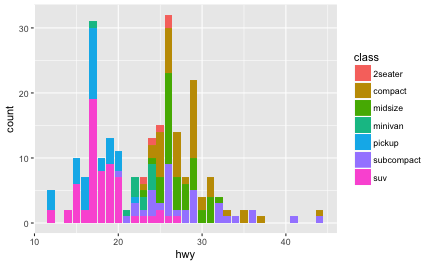
# a filled bar chart (fill the vertical height)
ggplot(data = mpg) +
geom_bar(mapping = aes(x = hwy, fill=drv), position="fill")
# a dodged bar chart (values next to each other)
# (not great dodging demos in this data set)
ggplot(data = mpg) +
geom_bar(mapping = aes(x = hwy, fill=drv), position="dodge")Check the documentation for each particular geom to learn more about its positioning adjustments.
Whenever you specify an aesthetic mapping, ggplot uses a particular scale to determine the range of values that the data should map to. Thus when you specify
# color the data by engine type
ggplot(data = mpg) +
geom_point(mapping = aes(x = displ, y = hwy, color = class))ggplot automatically adds a scale for each mapping to the plot:
# same as above, with explicit scales
ggplot(data = mpg) +
geom_point(mapping = aes(x = displ, y = hwy, color = class)) +
scale_x_continuous() +
scale_y_continuous() +
scale_colour_discrete()Each scale can be represented by a function with the following name: scale_, followed by the name of the aesthetic property, followed by an _ and the name of the scale. A continuous scale will handle things like numeric data (where there is a continuous set of numbers), whereas a discrete scale will handle things like colors (since there is a small list of distinct colors).
While the default scales will work fine, it is possible to explicitly add different scales to replace the defaults. For example, you can use a scale to change the direction of an axis:
# milage relationship, ordered in reverse
ggplot(data = mpg) +
geom_point(mapping = aes(x = cty, y = hwy)) +
scale_x_reverse()Similarly, you can use scale_x_log10() to plot on a logarithmic scale.
You can also use scales to specify the range of values on a axis by passing in a limits argument. This is useful for making sure that multiple graphs share scales or formats.
# subset data by class
suv = mpg %>% filter(class == "suv") # suvs
compact = mpg %>% filter(class == "compact") # compact cars
# scales
x.scale <- scale_x_continuous(limits = range(mpg$displ))
y.scale <- scale_y_continuous(limits = range(mpg$hwy))
col.scale <- scale_colour_discrete(limits = unique(mpg$drv))
ggplot(data = suv) +
geom_point(mapping = aes(x = displ, y = hwy, color = drv)) +
x.scale + y.scale + col.scale
ggplot(data = compact) +
geom_point(mapping = aes(x = displ, y = hwy, color = drv)) +
x.scale + y.scale + col.scaleNotice how it is easy to compare the two data sets to each other because the axes and colors match!
These scales can also be used to specify the "tick" marks and labels; see the above resources for details. And for further ways specifying where the data appears on the graph, see the "Coordinate Systems" section below.
A more common scale to change is which set of colors to use in a plot. While you can use scale functions to specify a list of colors to use, a more common option is to pre-defined palette from colorbrewer.org. These color set have been carefully designed to look good and to be viewable to people with certain forms of color blindness. This color scale is specified with the scale_color_brewer() function, passing the pallete as an argument.
ggplot(data = mpg) +
geom_point(mapping = aes(x = displ, y = hwy, color = class), size=4) +
scale_color_brewer(palette = "Set3")Note that you can get the palette name from the colorbrewer website by looking at the scheme query parameter in the URL. Or see the diagram here and hover the mouse over each palette for the name.
You can also specify continuous color values by using a gradient scale, or manually specify the colors you want to use as a named vector.
The next term from the Grammar of Graphics that can be specified is the coordinate system. As with scales, coordinate systems are specified with functions (that all start with coord_) and are added to a ggplot. There are a number of different possible coordinate systems to use, including:
coord_cartesianthe default cartesian coordinate system, where you specifyxandyvalues.coord_flipa cartesian system with thexandyflippedcoord_fixeda cartesian system with a "fixed" aspect ratio (e.g., 1.78 for a "widescreen" plot)coord_polara plot using polar coordinatescoord_quickmapa coordinate system that approximates a good aspect ratio for maps. See documentation for more details.
Most of these system support the xlim and ylim arguments, which specify the limits for the coordinate system (see above).
Facets are ways of grouping a data plot into multiple different pieces (subplots). This allows you to view a separate plot for each value in a categorical variable. Conceptually, breaking a plot up into facets is similar to using the group_by() verb works in dplyr, with each facet acting like a level in an R factor.
You can construct a plot with multiple facets by using the facet_wrap() function. This will produce a "row" of subplots, one for each categorical variable (the number of rows can be specified with an additional argument):
# a plot with facets based on vehicle type.
# similar to what we did with `suv` and `compact`!
ggplot(data = mpg) +
geom_point(mapping = aes(x = displ, y = hwy)) +
facet_wrap(~class)Note that the argument to facet_wrap() function is written with a tilde (~) in front of it. This specifies that the column name should be treated as a formula. A formula is a bit like an "equation" in mathematics; it's like a string representing what set of operations you want to perform (putting the column name in a string also works in this simple case). Formulas are in fact the same structure used with standard evaluation in dplyr; putting a ~ in front of an expression (such as ~ desc(colname)) allows SE to work.
- tl;dr: put a
~in front of the column name you want to "group" by.
Textual labels and annotations (on the plot, axes, geometry, and legend) are an important part of making a plot understandable and communicating information. Although not an explicit part of the Grammar of Graphics (the would be considered a form of geometry), ggplot makes it easy to add such annotations.
You can add titles and axis labels to a chart using the labs() function (not labels, which is a different R function!):
ggplot(data = mpg) +
geom_point(mapping = aes(x = displ, y = hwy, color = class)) +
labs(title = "Fuel Efficiency by Engine Power, 1999-2008", # plot title
x = "Engine power (litres displacement)", # x-axis label (with units!)
y = "Fuel Efficiency (miles per gallon)", # y-axis label (with units!)
color = "Car Type") # legend label for the "color" propertyIt is possible to add labels into the plot itself (e.g., to label each point or line) by adding a new geom_text or geom_label to the plot; effectively, you're plotting an extra set of data which happen to be the variable names:
# a data table of each car that has best efficiency of its type
best_in_class <- mpg %>%
group_by(class) %>%
filter(row_number(desc(hwy)) == 1)
ggplot(data = mpg, mapping = aes(x = displ, y = hwy)) + # same mapping for all geoms
geom_point(mapping = aes(color = class)) +
geom_label(data = best_in_class, mapping = aes(label = model), alpha = 0.5)"R for Data Science" (linked in the resources) recommends using the ggrepel package to help position labels.
ggplot2 is easily the most popular library for producing data visualizations in R. That said, ggplot2 is used to produce static visualizations: unchanging "pictures" of plots. Static plots are great for for explanatory visualizations: visualizations that are used to communicate some information—or more commonly, an argument about that information. All of the above visualizations have been ways for us to explain and demonstrate an argument about the data (e.g., the relationship between car engines and fuel efficiency).
Data visualizations can also be highly effective for exploratory analysis, in which the visualization is used as a way to ask and answer questions about the data (rather than to convey an answer or argument). While it is perfectly feasible to do such exploration on a static visualization, many explorations can be better served with interactive visualizations in which the user can select and change the view and presentation of that data in order to understand it.
While ggplot2 does not directly support interactive visualizations, there are a number of additional R libraries that provide this functionality, including:
-
ggvisis a library that uses the Grammar of Graphics (similar toggplot), but for interactive visualizations. The interactivity is provide through theshineylibrary, which we will learn later in the course. -
Plotly is a open-source library for developing interactive visualizations. It provides a number of "standard" interactions (pop-up labels, drag to pan, select to zoom, etc) automatically. Moreover, it is possible to take a
ggplot2plot and wrap it in Plotly in order to make it interactive. Plotly has many examples to learn from, though a less effective set of documentation. -
rChartsprovides a way to utilize a number of JavaScript interactive visualization libraries. JavaScript is the programming language used to create interactive websites (HTML files), and so is highly specialized for creating interactive experiences.
There are many other libraries as well; searching around for a specific feature you need may find a useful tool!
